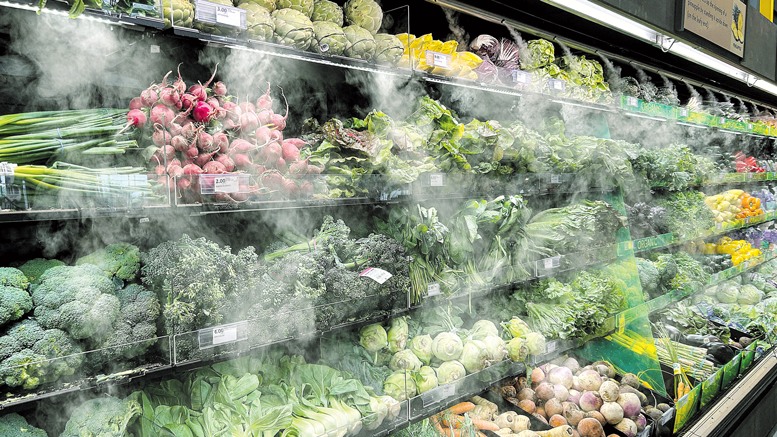Technologies Extend Produce Shelf Life
June 24, 2024 | 7 min to read
Misting equipment, like Prodew's **FogMist** system, is essential for maintaining moisture in fruits and vegetables, enhancing their appearance and extending shelf life. This technique, which utilizes an 8- to 12-micron range of fog, improves hydration without oversaturation, crucial for fragile items like leafy greens. Various innovations, such as Corrigan’s **Préserve**, create optimal humidity environments while minimizing energy consumption. Retailers must adapt misting strategies based on display types and product requirements to optimize freshness and reduce shrinkage.

PHOTO COURTESY CORRIGAN CORP. OF AMERICA
Misting equipment keeps fruits and vegetables looking fresh.
Originally printed in the June 2024 issue of Produce Business.
Misting helps keep fruits and vegetables from losing moisture, and that keeps them looking fresh and appealing, creating greater impulse sales. Let’s face it: Consumers won’t respond to wilted products.
Various technologies help extend shelf life and reduce shrink by controlling moisture levels. All of these technologies manage how water is dispersed on the product.
One of the biggest developments in misting over the last decade has been the size of the water droplet. Prodew’s FogMist system creates an 8- to 12-micron range of fog versus raindrop-type misting. The fog floats around the product, allowing produce to absorb the moisture slowly and naturally, resulting in high-quality items, like crisp greens and firm squash.
A benefit of a system like FogMist is product can stay in the case overnight, and much less case maintenance or cleaning is needed. FogMist can also help cut labor needs considerably.

PHOTO COURTESY PRODEW INC.
Itamar Kleinberger, co-founder of Prodew Inc., in Marietta, GA, says products have varying requirements and preferences, and display cases and shelving have different capabilities. He says sometimes traditional misting is the best option, and sometimes a system that produces fog, such as FogMist, is the best option.
“Additionally, the retailers may have different preferences regarding the systems they use. In addition to the misting or fogging track, a control system and other components are required to ensure the proper moisture is being dispersed on the specified schedule,” says Kleinberger.
Corrigan Corp. of America, headquartered in Gurnee, IL, offers several products that help extend shelf life, reduce shrink and control moisture. Préserve is its most recent innovation.
“This patent-pending technology is a non-wetting, 5-micron produce fogging system that protects perishables by creating an optimal wet rack environment,” explains Emily Stavrou, vice president of Corrigan Corp. of America. “The system creates a high-humidity environment that prohibits transpiration and extends product shelf life.”
Préserve requires low energy and water consumption and is engineered to be easy to maintain. The patent-pending, point-of-use nebulization technology has no water reservoir.
Stavrou says the clean fog is created with a closed plumbing system, exceeding health department requirements. “The integrated TriOBreeze-activated oxygen system automatically sanitizes produce cases and is proven to reduce harmful pathogens,” she says.
Kleinberger says Prodew’s design and engineering teams are always working to provide innovative solutions to the marketplace. This fall, it will launch a new product “that offers the look and feel of an ultrasonic system, but with the water efficiency and safety of our traditional misting systems,” says Kleinberger.
The new system can have many nozzles per system, spanning long distances on a single control unit. Additionally, there isn’t a water reservoir, so maintenance and associated health risks are eliminated. Kleinberger says the cost and maintenance of this system are considerably less than ultrasonic equipment.
FRAGILE GREENS
Misting and proper in-store handling are critical in the case of leafy greens. Greens are in demand for their health benefits, flavor profiles and convenience, but retailers must ensure the product looks absolutely fresh.
Bill Nardelli Jr., vice president of sales at Nardelli Bros.-Lake View Farms, Cedarville, NJ, says that, for most up-to-date food retailers, handling and merchandising practices are well established.
“Most of the retailers that we do large volume with have really advanced wet racks in the stores, and they’re able to keep product fresh on the shelf. They have a pretty good handle on that,” he says. “We have our own cooling to get everything down to the right temperatures. When they get to the store, they are displayed correctly on the wet rack.”
Stavrou has a unique perspective on keeping greens at their best.
“Corrigan is a proponent of misting greens with a very light, dew-like mist to hydrate greens without oversaturation,” she says. “Greens are fragile and have a water content of 95% which is higher than other vegetables. Leafy greens will wilt at just a 3%-5% water loss. So, it is crucial to provide optimal environmental conditions that slow down transpiration.”
David Bright, vice president of marketing for Grimmway Farms, in Bakersfield, CA, adds that vigilance is an important part of greens in the supply chain.
“As temperatures become cold, proper temperature control for leafy greens items is a priority to protect the product from chill damage, as well as vigilantly maintaining storage away from ethylene-emitting products,” he says.
Nardelli visits retailers and foodservice operators to see how they are handling greens and offers assistance to help them address any handling issues. And he’s seeing an industrywide improvement. On the retail side, for example, stores have updated to modern merchandising equipment and practices.
“They’ve made some advances in the past 10 or 15 years in how they’re displaying the wet items and making sure the proper misters are going and keeping them fresh in the produce sections,” he says.
Stavrou says Corrigan’s Préserve and UltraMist products permit flexible merchandising as needed in different displays and circumstances.
“The UltraMist has a shut-off option at each misting nozzle that easily slides on and off, allowing merchandisers to control moisture in every foot of the case,” she says. “The variety of perishable preservation offerings have allowed us to customize equipment based on case design and merchandising requirements effectively.”
DISPLAYS VARY
Retailers may have different preferences based on a wide range of variables, such as case or display style, product type, water quality, environmental factors and staffing capacities.
Some retailers have open refrigerated cases, some have doors on those cases, and others have open displays like some of the European, Latin, and Asian markets and some of the larger farmers markets.
“Traditional misting or FogMist could work in the traditional refrigerated cases, FogMist would be the ideal option for the cases with doors, and traditional misting would be the best choice for the open displays,” says Kleinberger.
Another example would be the product type or the way the products are displayed.
“Most vertical displays in retail grocery stores now tend to mix which products are displayed together. For example, peppers may be near beets, which may be near mushrooms. In this instance, FogMist would be ideal since it doesn’t wet the product, but instead focuses on maintaining the humidity level. However, if all the leafy greens and other products that like a high moisture content, like radishes, are together, then either traditional misting or FogMist could be good options,” says Kleinberger.
Kleinberger suggests a store can maximize a smaller floor space by displaying a wider variety of products in each case. Rather than dedicating an entire shelf to one product, they can divide the space to offer a wider variety of product.
“Another option is to offer more vertical displays to reduce the display footprint. FogMist would be ideal for either of these situations.”
Stavrou reminds that all misting systems were not created equal. “Corrigan offers five different nozzle patterns to accommodate various case styles. Our newest innovation is dry to the touch to allow for flexible merchandising. This means packaged and traditionally misted product can be merchandised next to each other.”
• • •
What is Involved in Misting Equipment?
Traditional misting systems are simple — all that is required is water, power and a drain.
Itamar Kleinberger, co-founder of Prodew Inc., in Marietta, GA, says a track with nozzles is installed in the case, which is connected to a control box that manages the misting schedule (mist frequency) and mist duration (length of the spray).
“Prodew has a dedicated installation and maintenance team, so once the store is ready, they’ll complete the installation in almost no time (of course, system length and other site variables will need to be considered),” says Kleinberger.
Depending on the water quality at the store, a water filtration system may be required. If the water is very hard, Prodew recommends adding a reverse osmosis system.
“Regardless of the system type used, minimal regular maintenance is required to ensure it continues to operate optimally. Maintenance mostly includes changing filters and checking nozzles,” says Kleinberger.
Emily Stavrou, vice president of Corrigan Corp. of America, Gurnee, IL, says misting equipment includes a mistbar, nozzles, controllers and customized water filtration. “All of our equipment is commercial grade. Our UltraMist system is NSF certified, and we are currently in the certification process for Préserve.”
3 of 16 article in Produce Business June 2024

